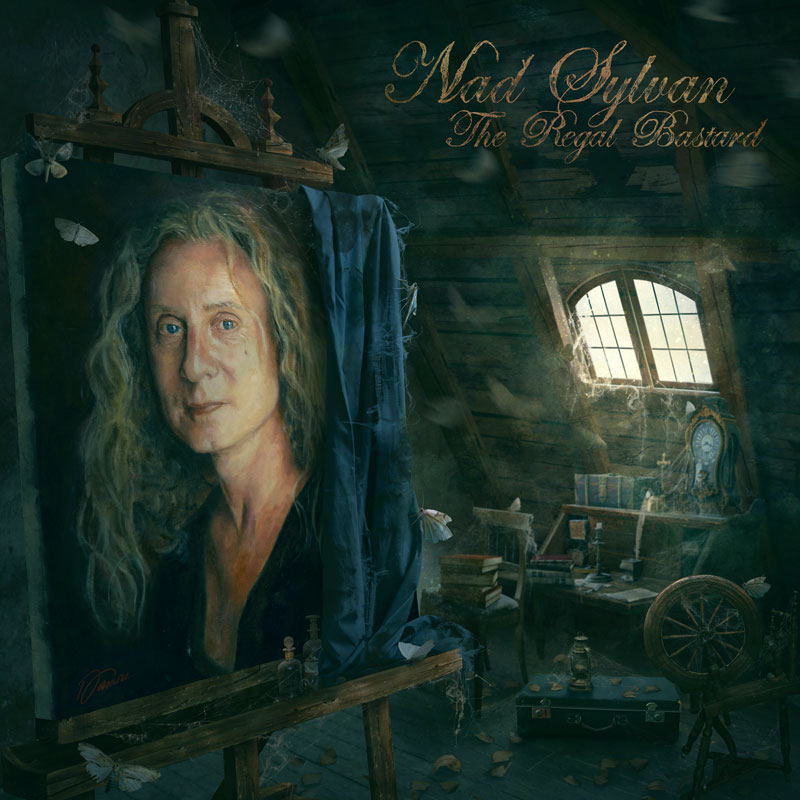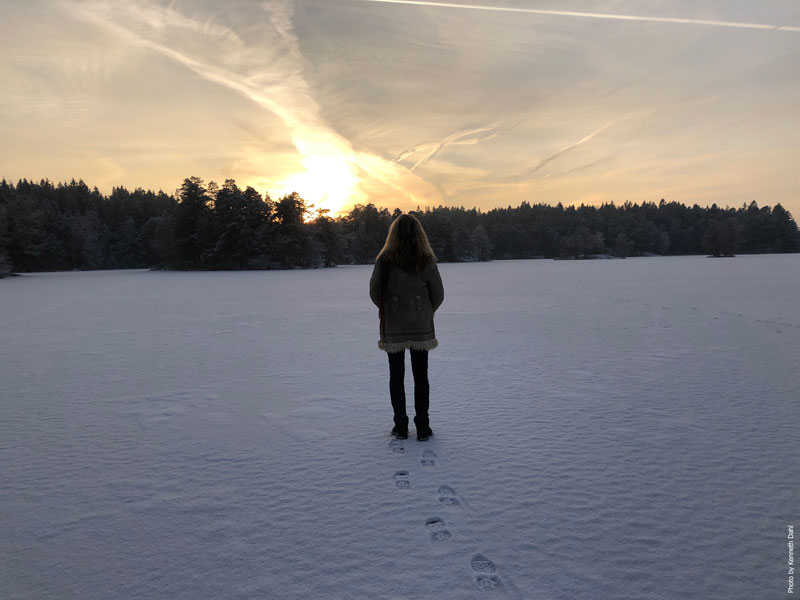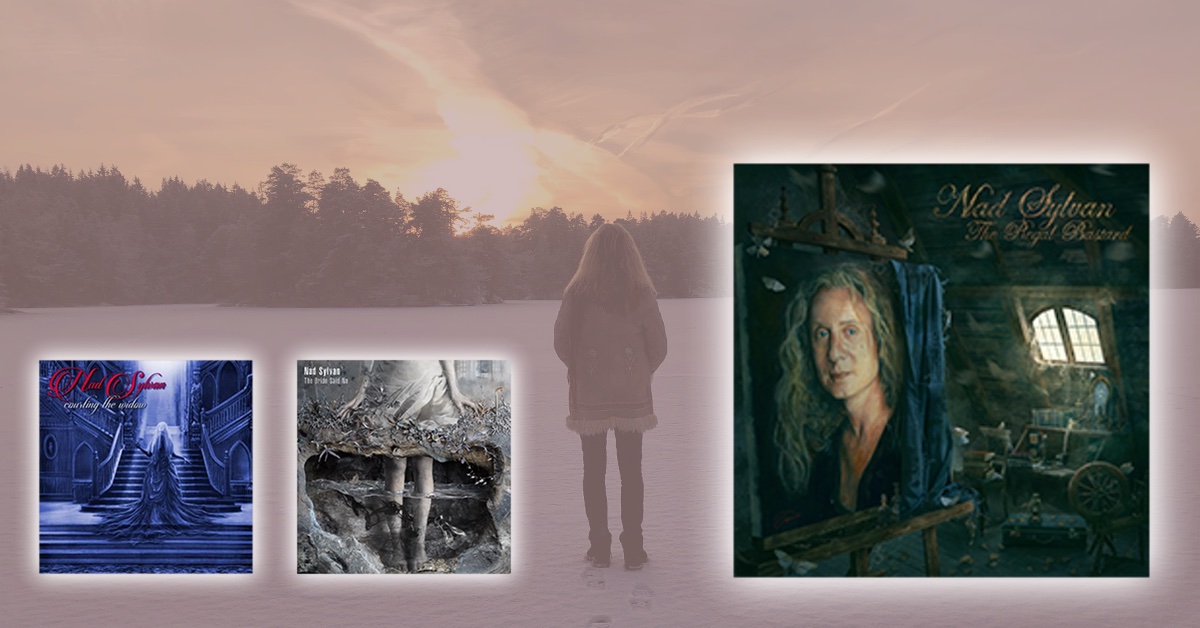- Article
- Read in 9 minutes
Nad Sylvan – Vampirate Trilogy – Part 3: The Regal Bastard (2019)
Nad Sylvan kept up the two-year interval and releases part three of his Vampirate trilogy, The Regal Bastard. Ole Uhtenwoldt explains what you can expect from the conclusion.
Prologue| Courting The Widow | The Bride Said No | The Regal Bastard | Epilogue
An attic. Books, suitcase and sundry antiques sit in the corners covered with thick dust. In the foreground there is a painting covered only in parts with a cloth, and it shows Nad Sylvan looking at you. There is no reason to doubt that this is the face of the vampirate. So this artwork is different from those of the previous two albums.
Work on its successor began barely three months after the release of The Bride Said No. Because of other commitments that also involved Steve Hackett Nad could only work on the album in fits and starts. This was an advantage in retrospect because his ideas had time to evolve before he took them, fully matured, into the studio. The Regal Bastard was originally meant to be the title of the second album before The Bride Said No (a title Nad had had in mind for many years) won the day. The Regal Bastardis not meant as an insult but refers to the original meaning of the word: a child born out of wedlock, in this case a son of a king, as the title implies. The album has a different sound than the earlier two; it is richer and dreamier without losing the substance of the previous two. It certainly keeps up the standard he set with his earlier albums..
Most of the crew that helped Sylvan sail through the second part has reassembled for this album. There are fewer guest musicians and a larger role played by the “core band”. Still, the parts Steve Hackett and Guthrie Govan bring to the table are highlights on the album.
Will there be a happy ending? Is the vampirate going to make his peace? Just some of the questions that arise … so onward ho, towards the end of the journey!
I Am The Sea (7:48)
Like the first album of the trilogy four years earlier this one starts with the sound of breaking waves that is soon interrupted by a threatening melody from a musical box. The verse begins soon after, and the line “in the fear of the light” removes all doubts as to who is speaking. The opening song is completely different from what you might expect from the previous albums. It is also the gloomiest song of the trilogy. The verses are spoken rather than sung, they are intertwined and accompanied by few instruments. The chorus lets out all the emotions the hero of this story goes through. The contrast to the ghostly verse lifts the chorus to an extremely melodic level. After a reprise of the first verse Guthrie Govan’s guitar swells in to a solo. He nearly plays himself into ecstasy while the soundscape around him contracts, compresses and gives the vampirate free reign again. The opener (of this and the previous album) is a great song that attracts the attention of the listener. Paul Mabury plays the drums on this song (only), and the song shows why Nad hired him for it. Also note how well Nad the backing singer supports Nad the frontman.
This first surprise fades into the sound of the sea again, and the next surprise follows for we continue straight into the odd rhythm of …

Oahu (4:19)
… that almost sounds like a waltz. Oahu is the central island of Hawaii and harbours its capital, Honolulu. The chorus is very strong again. The song itself sounds elysian, and it mentions the regal bastard for the first time – a message in a bottle has been washed ashore. With all its splendidly likeable quirkiness Oahuis a fun song. It reminds me of the humorous bits Genesis and other bands in the 1970s would occasionally perform. Nad’s delight in this song is evident and a good suggestion that you shouldn’t take your own songs too seriously. The journey through those varied territories continues, and there are surprises behind every corner.
Whoa (Always Been Without You) (7:22)
Another transition introduces the electronic rhythm of the next song. Whoa is one of the more normal songs. It works without being aloof, which makes it a prime example of what Nad means when he talks about “pop going prog”. Whoa is actually a well-constructed pop song with progressive elements. Nad’s voice is staged very well. The song proves that keyboards (played by Nad) and guitars (and a guitar solo) can carry a song. It is modest and unobtrusive, but very interesting soundwise – a charming ballad.
Nad conceived of this idea in the summer of 2018 in Italy. With this background the source of the joyful exclamation “Whoa” is obvious..
Meet Your Maker (6:35)
Things turn serious now. After a rock intro the leitmotive is introduced on harpsichord and guitar. The middle of the album is set up as a duet. Nad sings the first of the very dynamic verses. After the chorus Tania Doko makes the appearance we could expect from the previous album. Her performance is very strong; her yearning and aggressive singing sounds almost like a bride who questions her former decision. Meet Your Maker could be a kind of successor to The White Crown; the humorous parts of that give way to rising levels of drama. We are in the last part of the trilogy and headed for the climax. Tony Levin’s rumbling bass works perfectly in this compelling piece; he is supported strongly by Nick d’Virgilio.
After all this confusion we meet the protagonist…
The Regal Bastard (12:20)
The first seconds of the title track sound like something from Anthony Phillips’s album The Geese And The Ghost. It uses melodic structures that make you think of the Middle Ages – which makes sense because this is the only track in the whole trilogy to use a real orchestra. The intro dissolves into cascading piano sounds with Nad’s vocals that develop into the chorus. The line “The Regal Bastard and I” appears again and again with different instruments and different phrasing … someone seems to set great store on the regal bastard, and the hints thicken that it is, in fact, the quartermaster from the second album (which also has a “bastard son” in it). The lyrics also mention that the regal bastard had assumed some sort of cover when he was noticed; this also applies to the Vampirate who has the face of a young man.
Though the song has a lot of dynamic changes between loud and quiet moments it does not have too much pathos. It also shows off Jonas Reingold’s characteristic bass playing. This title song is a musical highlight of the album cycle and proves how much fun the band have at playing. The Regal Bastard is a well-written, very noble portrait of a special relationship between special characters; it takes a very august position. It sounds more fragile, gentle, less violent than the title track, The Bride Said No, which matches the basic mood of the album. And it is good that this is not yet the finale … it ends with the wind under the wings of the Vampirate.
Leave Me On The Waters (5:48)
Instead of stormy seas we hear a stream tinkle. Gently piano chords are accompanied by the same keyboard sounds that also introduced What Have You Done on the previous album. The song moves slowly through chorus and verses like a sunset of a few minutes – a harmonious ballad that illustrates the protagonist’s desire to make his peace in waters far from the raging sea. The quartermaster has indicated the same: A happy life on an island, rest above everything and a ruined lighthouse. The Vampirate ponders his real goals in life. In the end he even seems to have made his peace with being stood up at the altar.
As in the album opener, Guthrie Govan plays a guitar solo. It sounds very harmonious, seems to illustrate the inner life of the protagonist and gives a sense of closure to song and album. The story comes full circle, and after a final chord the music moves into the finale …
Honey I’m Home (3:01)
The relaxed atmosphere of the previous song continues. This is a kind of solemn anthem on the Vampirate who has found his home in the sea. The cycle began with Carry Me Home, which expressed the desire for a kind of home. And it took three albums to get there. Freely strummed acoustic guitar with an animated chord sequence that reprises the chorus of Carry Me Home move lively takes us into a grand choir part in which Jade Ell, Sheona Urquhart and Nick Beggs participate. The honour of a final solo on the album goes, of course, to Steve Hackett. And it is a typical, strong Hackett solo that stresses the dynamism of this brief instrumental. The fact that it is an instrumental is also a kind of statement: The Vampirate has arrived, nothing needs be said, and the sound speaks for itself. Which is particularly evident when the sound of running water fades in and gives the impression (according to Nad) that Steve played his solo under a waterfall. The leading melody reveals itself as a longer version of the chorus from Whoa. This reprise is the definitive ending.

Thus ends the story of the Vampirate, in which we have learned much of what he has lived through, his dreams and his fears. The Regal Bastard sounds more reduced than its predecessors, but in a charming way. Drama can be created without lots of loud songs as the last album of this trilogy shows. It sounds even more organic than the previous two albums and focuses more strongly on a certain style without neglecting lots of variations. The album fits in the overall picture of the trilogy. It shows colourful soundscapes with its exotic instruments, and introduce a few new ones (cf. Oahuor the title track).
Two other tracks came about during the work on The Regal Bastard. According to Nad, these have nothing to do with the story line and should be set apart from the album. They are still worth looking at and listening to because their quality is right up there with the songs from the album. Their only fault is not fitting into the frame of the story.
Diva Time (4:48)
This is the second joint composition by Nad and Anders Wollbeck (I Am The Sea is the other one). It begins with a background noise of many people talking – a wedding reception, perhaps? Before we can muse about that a harpsichord provides the rhythm for the verses. The harpsichord has become an important stylistic device over the span of the trilogy. While beautifully sad and ghostlike chords carry the verses the chorus has a fair bit of drama in it … if you expected another lesson in humour you will be caught on the wrong foot. Diva Time is mordant, quite short-tempered and a tad lah-di-dah – in a word: diva. When Nad does not sing but speak the chorus after the bridge it is a devilishly strong moment.
This track has Aaron Sterling on drums, who has worked with a remarkable list of musicians from the field of pop. Nad plays the bass himself, and he does it so well that he could have done it more often on the trilogy. Anders Wollbeck plays a guitar solo to remember.
The Lake Isle Of Innisfree (3:41)
Plucked acoustic guitar introduces a deep and idyllic ballad. The composition is based mainly on ideas by Andrew Laitres, a Canadian musician who plays all the instruments (except for the cello, which is played by Yann Marc).
The lyrics of this precious gem consist only of the poem The Lake Isle Of Innisfree (1888) by the Irish poet William Butler Yeats. Setting poems that obviously have their own rhythms to music can be a challenge. This attempt works so well because the harmony of the words fits perfectly into the accompanying music. The music reflects the mood of the poem, and if you only read the poem first you may hear exactly the kind of music in your mind’s ear that is realized in this track. This makes the song so special. Nad has found the right means of carrying the words through the music before this wonderful piece of music repeats the chords from the verse during the last minutes with a string crescendo that ends in an organ chord..
The encores prove again the immense range of musical styles Nad Sylvan uses in these albums: he moves from classic and harder (retro-)prog to New Artrock to romantic ballads to soul sounds. The bonus tracks fit into the overall picture. They may have seemed foreign on the album but they do have the same quality as the other tracks.
Now we can look back across the whole journey.
…on to the Epilogue
Order The Regal Bastard from: amazonUK | iTunes
by Ole Uhtenwoldt (06/2019), English by Martin Klinkhardt

